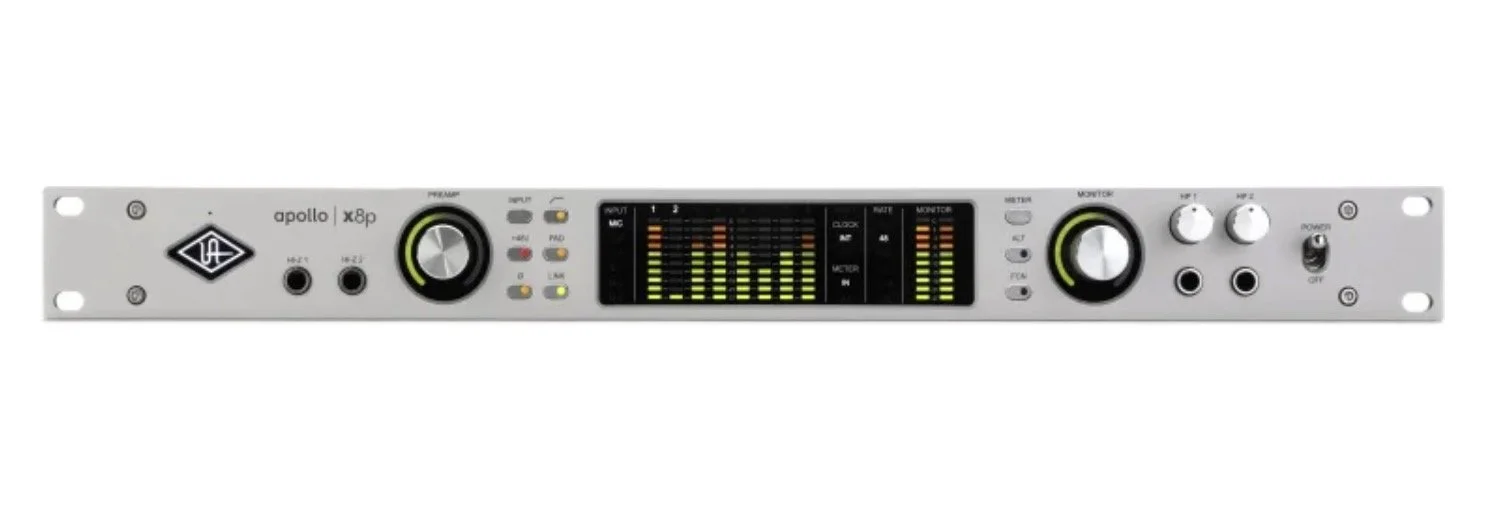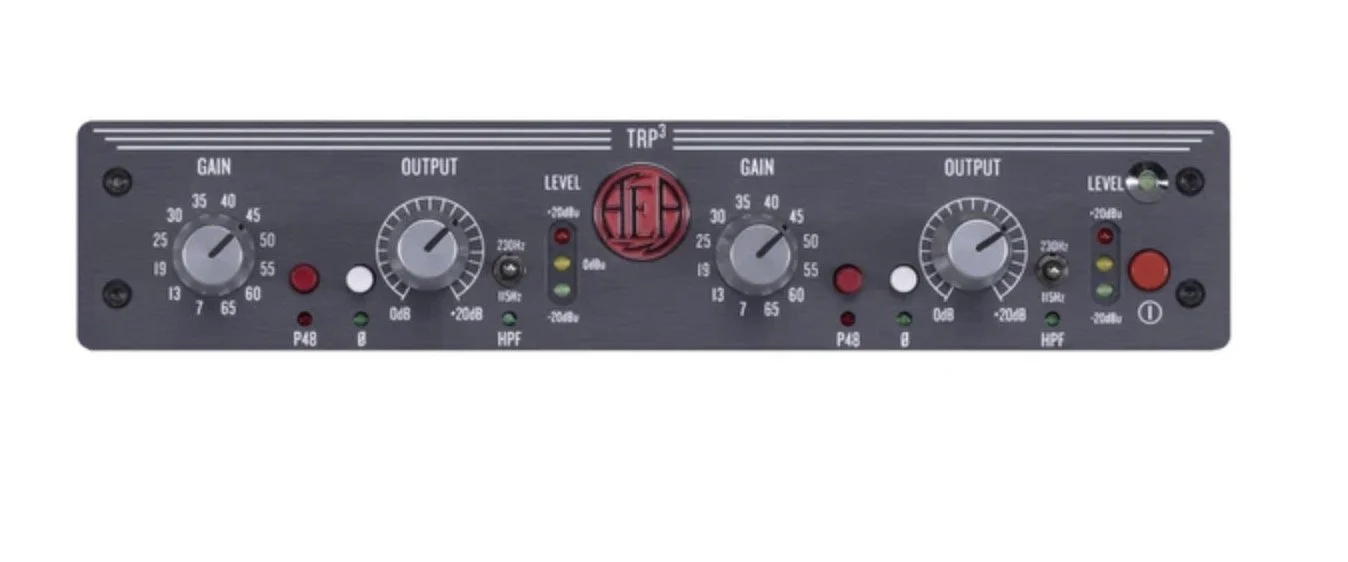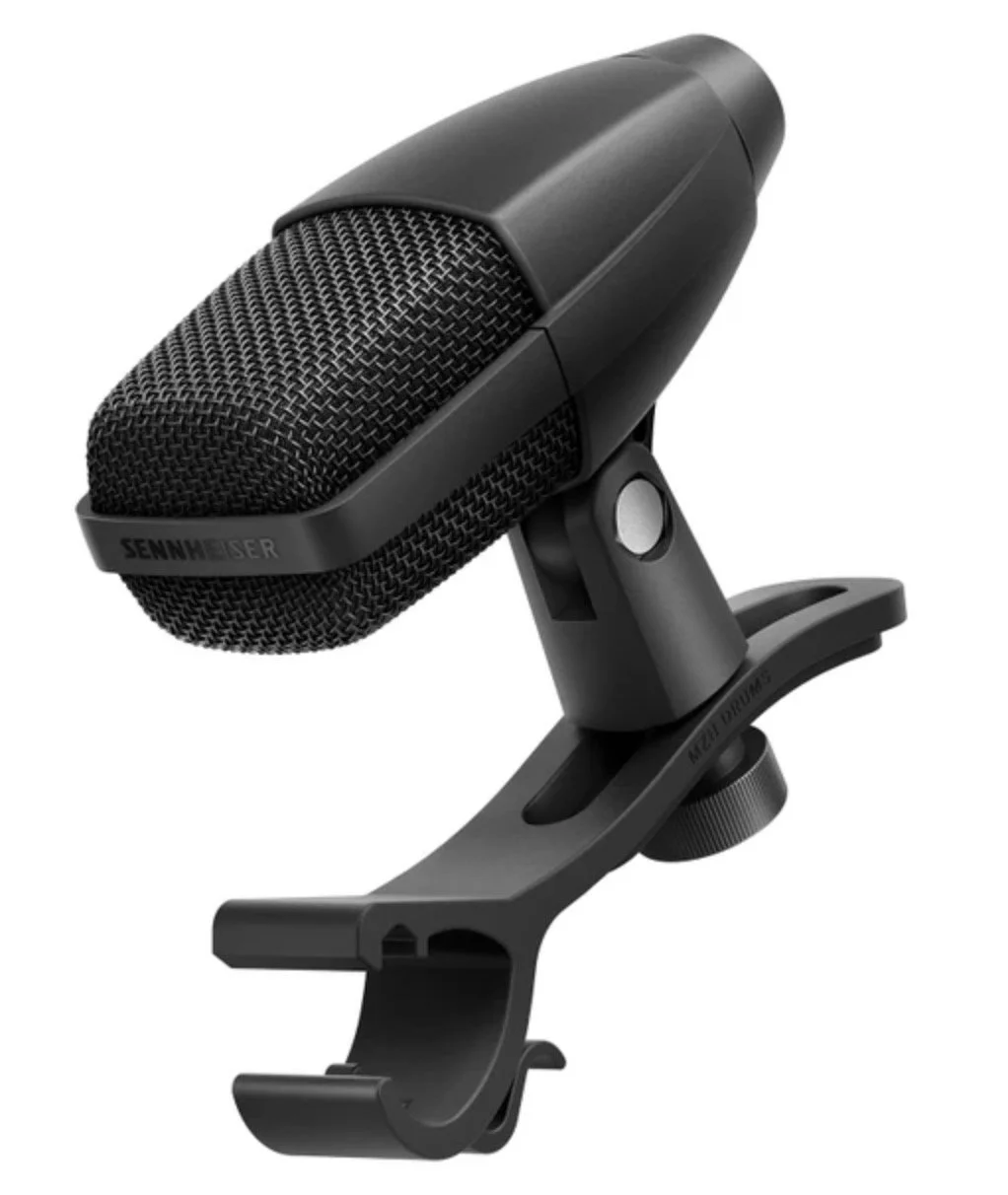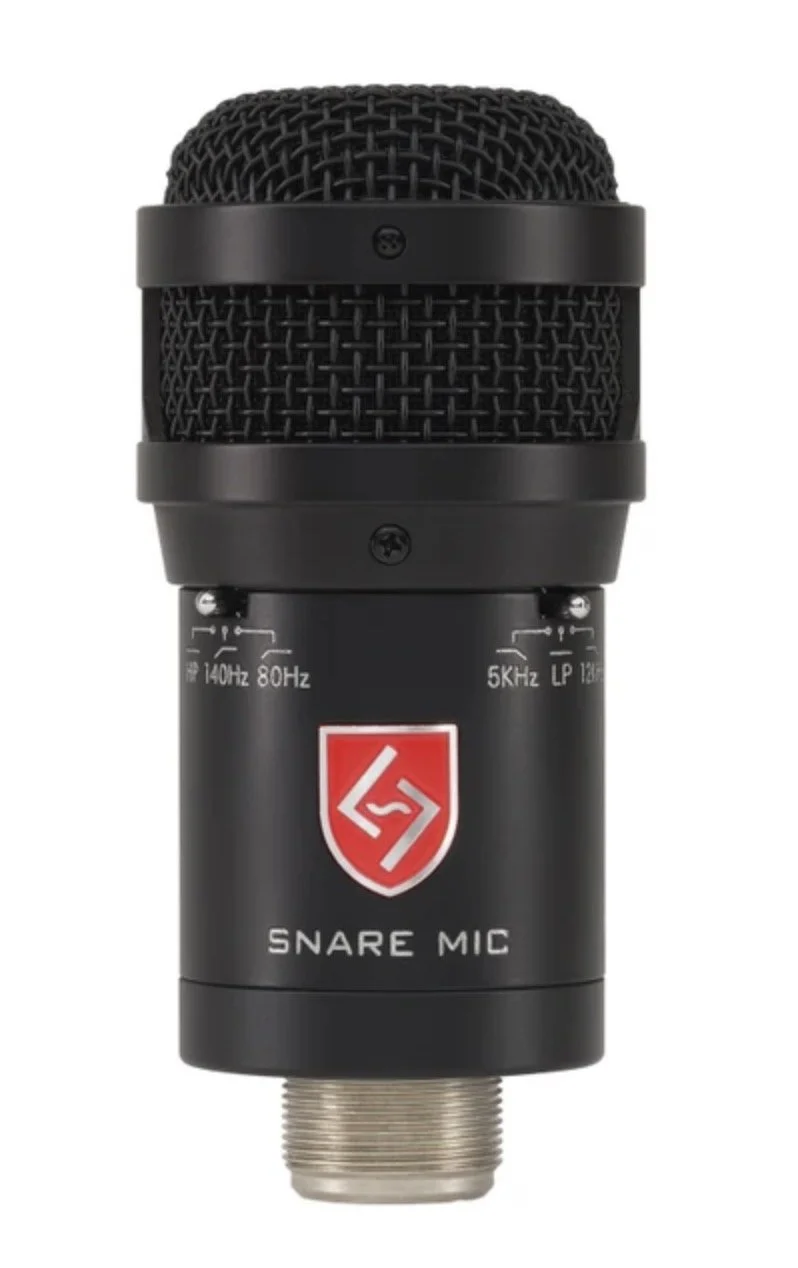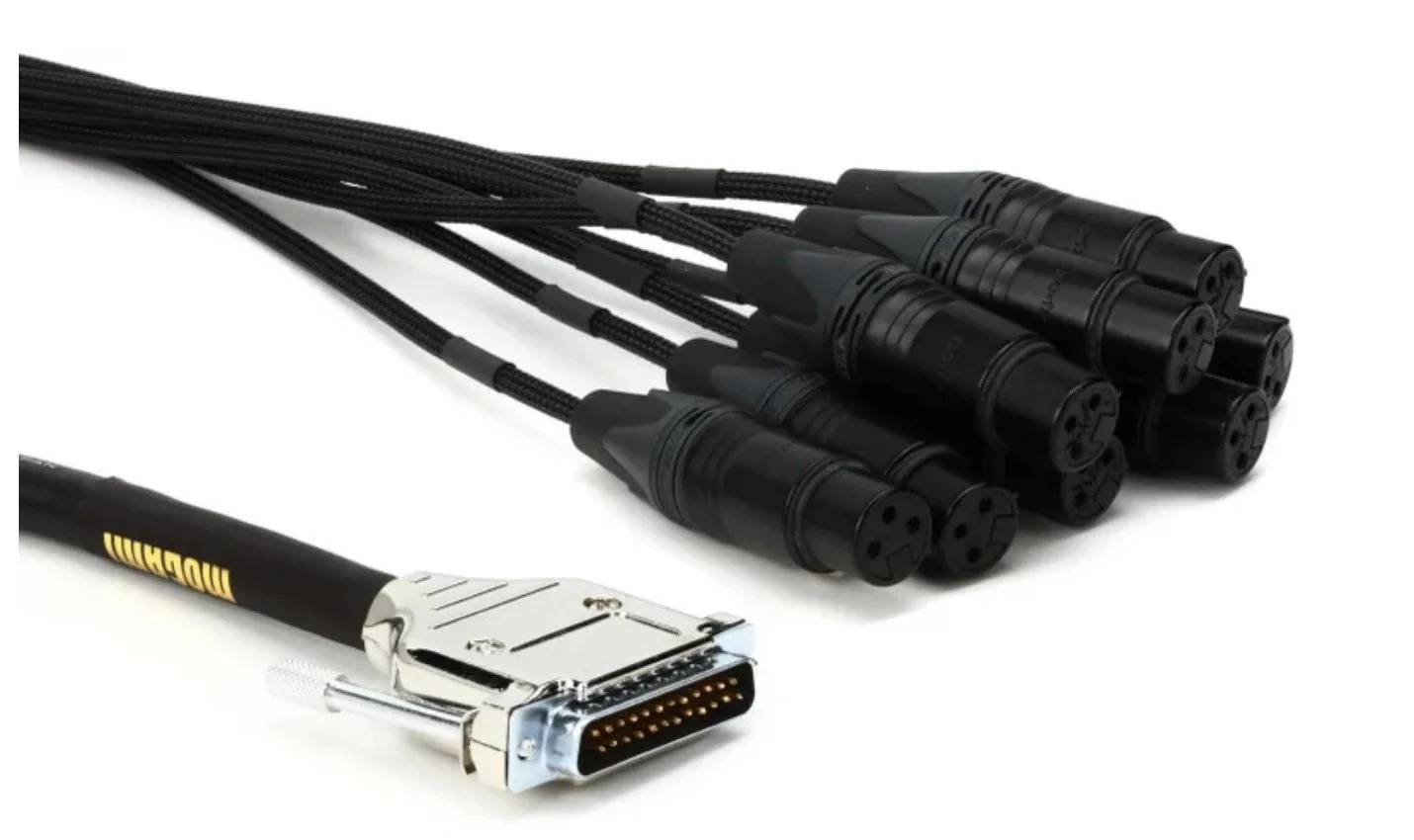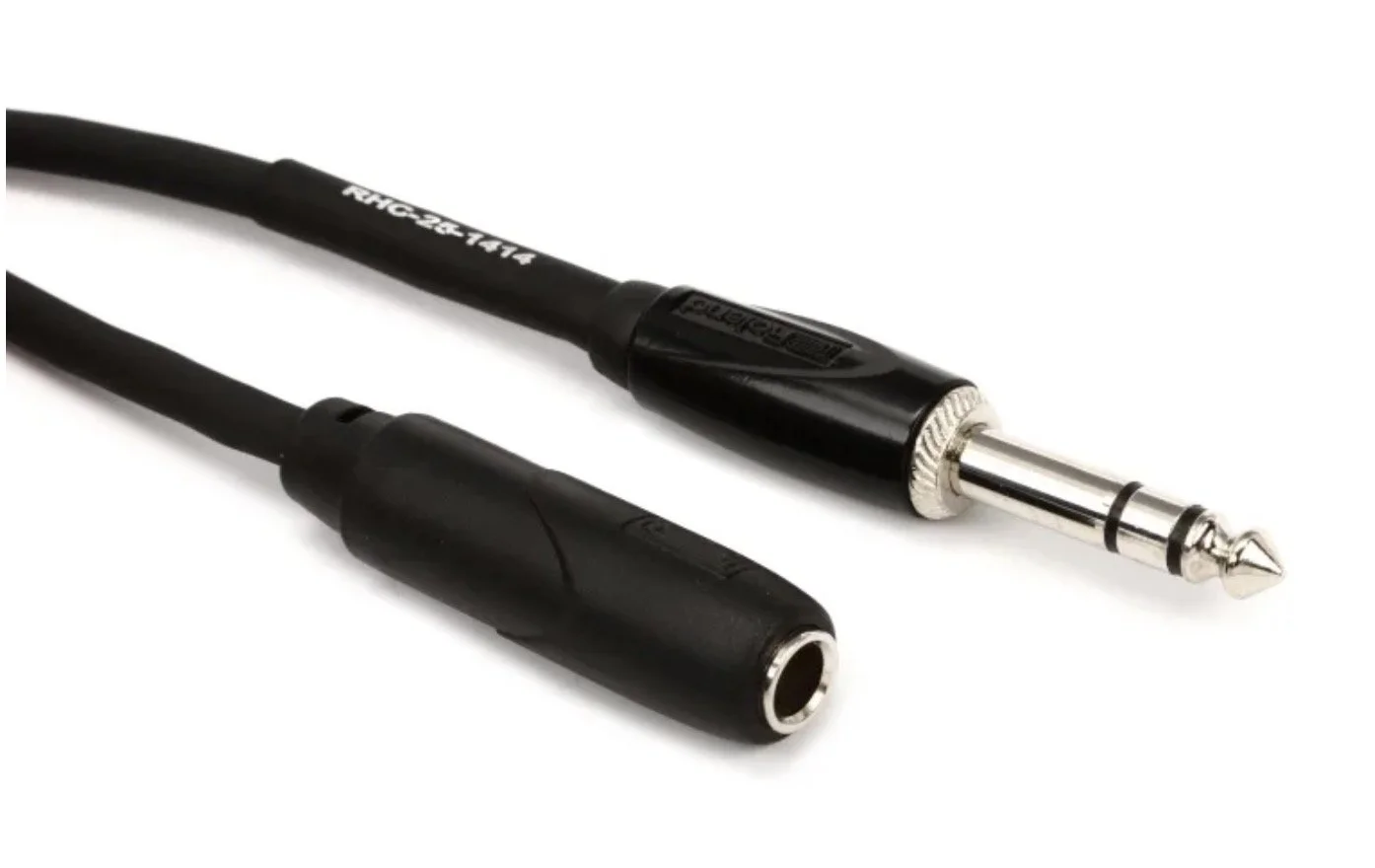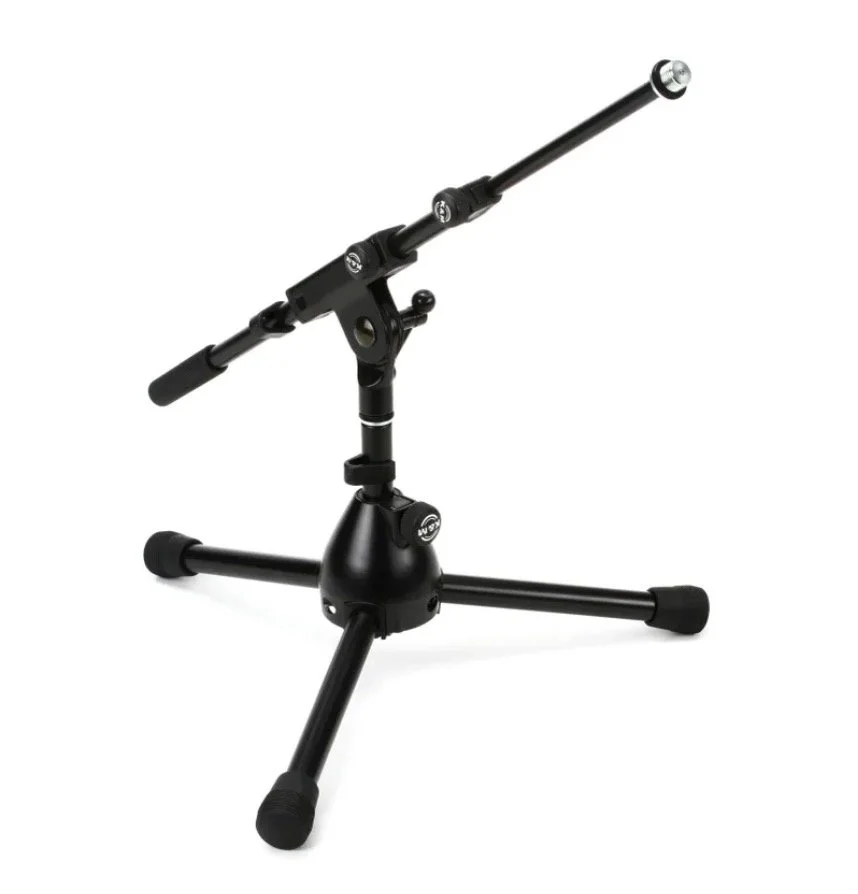Building a drums-focused professional recording studio for under $14,500
It’s another pro-quality home music studio build! This time, we’re focusing on building a space to capture a drum kit at a professional level of quality. This will require many more recording channels, microphones, acoustics work, cabling, and generally be much more involved than my other home studio builds.
Because we have to fill out so many recording channels to accurately capture a complex instrument like a drum kit, our total cost has gone up significantly compared to other builds. If you’re thinking about spending this kind of money, you’re probably looking to operate your studio as an income generating business.
For my complete list of recommended audio gear optimized for use at home, reference the Home Studio Gear Guide.
Our final budget
Here’s our gear list: we’ve come in under budget by $43!
Audio Interfaces and Mic Preamps
Universal Audio Apollo x8p Gen 2: $3499
AEA TRP3 Two-channel Half-rack Microphone Preamp: $1299
Monitoring
ADAM Audio T7V 7 inch Powered Studio Monitor Pair with T10S 10 inch Powered Studio Subwoofer: $765
Audio-Technica ATH-M50x Closed-back Studio Monitoring Headphones x2: $298
Microphones
Coles 4038 Studio Ribbon Microphone, Stereo Matched Pair: $2963
Shure Beta 91A Boundary Kick Drum Microphone: $249
ElectroVoice RE320 Cardiod Dynamic Microphone: $295
Sennheiser MD 421 Kompakt Dynamic Microphone x3: $897
Shure SM57 Dynamic Instrument Microphone: $99
Lauten Audio Snare Mic FET Condensor Microphone: $398
Cabling
Pro Co EVLMCN-25 Evolution Microphone Cable - 25 foot x10: $499
Mogami Gold TRSXLRM-15 Balanced 1/4-inch TRS Male to XLR Male Patch Cable - 15 foot x2: $160
Mogami Gold DB25-XLRF 8-channel Analog Interface Cable - 5': $269
Roland RHC-25-1414 Headphone Extension Cable - 1/4-inch TRS Female to 1/4-inch TRS Male - 25 foot: $32
Stands and clips
Behringer SM5002 Heavy-Duty Height-Adjustable Monitor Stand Set: $69
Ultimate Support MC-125 Studio Series Microphone Boom Stand x2: $598
Lauten Audio Rim mount: $99
K&M 25950 Extra Low Profile Tripod Base Boom Mic Stand x2: $204
Acoustics
Acoustic treatment: first reflection points: $315
Acoustic treatment: corner bass traps: $1100
Acoustic treatment: estimated shipping costs: $350
Total: $14,457
Design assumptions
This build aims to develop a space to record a drum kit at a professional level of quality. It would be a good starting point for setting up a very nice drum recording room as an income-generating business, or an initial gear backbone needed to set up a drum kit recording area inside of a larger, more full-service recording studio set up to record complete bands. Using this gear setup, you could start out your business operating as a very high quality drum recording room, then use the income generated to expand operations into full band recording and mixing later on.
While I’m including studio monitors in this build, in order to keep the budget reasonable I haven’t also included the additional acoustic treatment needed to professionally mix any of the drum tracks you would record inside of a space like this.
So, if you’re wanting to get into mixing as well, using this buildout as a starting point, I’d plan on spending even more on the acoustic treatment setup surrounding your mix position. If you have the floor space, building a separate control room with its own dedicated acoustics profile is the best way to get both professionally recorded and professionally mixed drums, when working under the same roof.
For best results using this particular buildout, I’d plan on sending the high-quality drums tracks you’d be able to record in this space out for mixing elsewhere, or taking those tracks into another studio to mix them yourself.
Also, refer to my acoustics notes inside of my mixing-focused build: the acoustics tools noted here are for demonstration and educational purposes only. Don’t just go out and buy these exact same items and install them. Instead, make sure you perform an acoustics analysis yourself, or consult with a licensed acoustician, before determining the specific treatment you need inside of your individual room.
Audio Interfaces
Universal Audio Apollo x8p Gen 2 ($3499)
Universal Audio Apollo x8p Gen 2 audio interface.
To record high-quality drums in a modern style, you will want between 8-16 recording channels to work with. For recording entire bands live, closer to 16-24 channels would be the minimum number of channels I’d recommend. For a drum room only, you might be able to get by with just 8-12 channels.
Remember, some of the very best drums in studio history were recorded using just 4 mics, so limitations can inspire creativity! More microphones on the kit doesn’t always equal better sounding drums; it’s also about how you use the mics that you do have.
I’ve chosen a solid middle-of-the-road 16 channel interface here; capable, and a unit that includes 8 mic preamps built in, while also providing the flexibility to add additional preamps purchased separately.
16 recording channels would be the minimum I’d recommend for anyone attempting to open a full-service recording and mixing studio that records entire bands live in the room. So, if you’re using this build to start out your studio business recording drums, and then hoping to expand into full band recording later on, this interface choice will allow you to do that.
This is a Thunderbolt interface, which should have good future-proofing in most situations, and allow for many years of recording before an upgrade would be necessary. Make sure you check compatibility with your computer system before purchase.
Universal Audio makes some solid gear, however if you have the budget I’d recommend considering the Lynx family of audio interfaces. They’re more expensive, but they’re my preferred choice and what I use myself, and I’ve found the increased sonic quality more than justifies the increased cost.
Remember, every signal you record is going to pass through your interface, so this is an area where it might make sense to focus on quality in addition to price.
Mic preamps
AEA TRP3 Two-channel Half-rack Microphone Preamp ($1299)
AEA TRP3 Two-channel ribbon microphone preamp.
The Universal Audio interface I’ve chosen already includes 8 mic preamps built in, so why am I spending money on additional preamps? Two reasons:
For maximum flexibility in our drum kit recording setup, adding two recording channels (for a total of 10 when including the built-in interface preamps) can be helpful.
These particular preamps by AEA are designed especially for the ribbon mics I’m recommending for use as drum overheads. They have a ton of gain (ribbons are generally low-output mics), and also super high impedance, both technical specs that will allow us to capture lovely, natural sounding drums while using our ribbon mics. When we’re spending the big bucks on top-of-the-line ribbon microphones, getting dedicated ribbon preamps can really help those particular mics sound their best. Hint: these specialty preamps will also make your dynamic mics sound great!
Monitoring
ADAM Audio T7V 7 inch Powered Studio Monitor Pair with T10S 10 inch Powered Studio Subwoofer ($765)
ADAM T7V studio monitor and subwoofer bundle.
The ADAM Audio TV7s are a strong entry point into professional studio monitoring, particularly when paired with a subwoofer. This is a very attractive bundle at a very reasonable price, given the quality of this brand.
If you have a more money to spend, you might consider the Genelec series of monitors; they’re significantly more expensive (several thousand dollars for monitor and subwoofer combos), but they’re what I personally use, and I’ve found the quality justifies the increased cost.
Starting off with something pro quality yet a little cheaper like the ADAMs, and then adding a secondary monitor setup as your studio develops and starts to generate income, is a common move done by many studio pros building out their studios.
As with all subwoofer setups, the placement and calibration of your subwoofer is critical! A poorly placed subwoofer can cause more sonic issues that it solves when it comes to mixing, so do your research and be sure you’re comfortable properly calibrating this gear before committing to a subwoofer based monitoring setup.
Audio-Technica ATH-M50x Closed-back Studio Monitoring Headphones x2 ($298)
Audio-Technica ATH-M50x headphones.
I’ve included two of the classic M50x closed-back monitoring headphones for this build; one for you, one for the drummer.
Microphones
Coles 4038 Studio Ribbon Microphone, Stereo Matched Pair ($2963)
Coles 4038 ribbon microphones.
I love using ribbon mics as drum overheads. They sound warm and natural, and do a great job at smoothing out snappy and harsh cymbal sounds. These matched pair Coles 4038’s are expensive, but that’s for a reason; these are some of the best-sounding ribbons you can buy.
Shure Beta 91A Boundary Kick Drum Microphone ($249)
Shure Beta 91A Boundary Kick Drum Microphone.
This is a specialty microphone designed to capture the lowest sub frequencies, especially when used with a kick drum. This mic is often placed inside the kick drum body to capture the batter head of the drum and the resonance inside the body of the drum, and can be a useful tool in getting some extra thickness into your kick drum sound.
ElectroVoice RE320 Cardiod Dynamic Microphone ($295)
ElectroVoice RE320 Cardiod Dynamic Microphone.
This is a high-quality general purpose dynamic microphone that works great for capturing nice thick, natural sounding kick drums. It’s also got a lot of versatility: try it on bass cabs, or for podcasting. This is a slighter cheaper and more instrument-focused variant of the RE20, one of Electro-Voice’s most popular dynamic microphones.
Sennheiser MD 421 Kompakt Dynamic Microphone x3 ($897)
Sennheiser MD 421 Kompakt Dynamic Microphone.
The regular sized Sennheiser MD 421 is a pro studio classic on tom-toms. The “Kompakt” version is a slightly smaller variant of the same mic, optimized for use on drums, with an improved clip for direct mounting on the drum rim. I’ve included three of these mics, one for each tom-tom (two rack toms and one floor tom). This gets you all of the great sound of the full-sized MD 421, in a drum-optimized package that’s way easier to set up and use day-to-day.
Because these mics include integrated drum clips and mount directly to the drums, we can also save a little money by not needing to purchase additional mic stands for this application.
If you have more money to spend and are looking for the very best in drum tom capture, considering upgrading one of these three mics to the Sennheiser MD 441 U. It’s significantly more expensive and didn’t fit into this budget, but it’s a gold standard when it comes to capturing studio-quality floor toms. Double-micing a floor tom (micing both the batter and resonant heads) can also be an interesting mic setup option to experiment with.
Shure SM57 Dynamic Instrument Microphone ($99)
Shure SM57 Dynamic Instrument Microphone.
Another studio classic, I’m including this as a snare drum mic (for either the top or bottom head). Using an SM57 on snare is one of the best uses for this particular microphone; even though it’s a cheaper mic, it’s got a very classic sound when it comes to the snare drum.
Lauten Audio Snare Mic FET Condensor Microphone ($398)
Lauten Audio Snare Mic FET Condensor Microphone.
A bit of an unusual choice, this is a condenser microphone that’s been specifically designed to capture snare drum. It’s got a tone of tone-shaping options built into the mic for this purpose. I really like its ability to capture the thicker body tone of the snare drum, and in that way this mic is complementary to the SM57’s brighter sound. These two mics, when used in combination on the top and bottom snare heads, would allow a lot of flexibility in capturing various snare styles of snare tones. Try using this Lauten Audio mic on the top head with the SM57 on the bottom head, for a nice thick snare sound that still retains brightness.
Cabling
Cables are disposable items in the recording studio, and spending a little bit more can get you a longer-lasting, more durable cable (up to a point). We don’t want low-quality, buzzing cables ruining our recordings, but we also don’t want to overspend on a disposable item that will need replacement on a regular basis.
In this case, I’m going for mid-level options for our mic cables that will see greater wear and tear, and higher-end options for our behind-the-desk applications.
Pro Co EVLMCN-25 Evolution Microphone Cable - 25 foot x10 ($499)
Pro Co EVLMCN-25 mic cable.
A solid mid-level cable choice, these will hold up to daily use while not being prohibitively expensive when it comes time for replacement. I’ve included 10 of the 25 foot version here; that’s one for each microphone plus a spare. Be sure you measure your space before purchase; you don’t want to buy cables and have them end up being too short for your individual room.
Mogami Gold DB25-XLRF 8-channel Analog Interface Cable - 5' ($269)
Mogami Gold DB25-XLRF 8-channel Analog Interface Cable.
This interface cable connects to the DB25 port on the back of the Universal Audio interface, and unlocks the additional 8 available recording channels on the interface that aren’t served by the 8 built-in preamps. For this setup, you’d connect these cables to the outputs of the AEA ribbon mic preamp.
As you expand your studio, this cable will allow you to connect additional dedicated outboard mic preamps you might decide to purchase later, or allow interfacing with a patchbay for more advanced studio routing techniques.
Mogami Gold TRSXLRM-15 Balanced 1/4-inch TRS Male to XLR Male Patch Cable - 15 foot x2 ($160)
Mogami Gold TRSXLRM-15 patch cable.
For our behind-the-desk cables, these ones connecting our studio monitors to our interface, I’ve chosen the top-of-the-line Mogami cable. These cables will last for years in a low-traffic environment, and minimize our needing to go behind the desk to cable manage and troubleshoot shorts and buzzes while we’re using them.
Roland RHC-25-1414 Headphone Extension Cable - 1/4-inch TRS Female to 1/4-inch TRS Male - 25 foot ($32)
Roland RHC-25-1414 Headphone Extension Cable.
This cable will allow you to plug your drummer’s headphones into the Universal Audio interface, while they’re sitting farther away at the drum kit, for monitoring during recording.
Microphone stands and clips
Ultimate Support MC-125 Studio Series Microphone Boom Stand x2 ($598)
Ultimate Support MC-125 Studio Series Microphone Boom Stand.
Since we’re spending big money on expensive studio ribbon mics for our drum overheads, we need nice beefy counterweighted stands to support them. This is one of the most adjustable boom stands on the market; the counterweight is adjustable for optimum balance, the base weighs a full 35 pounds for a sturdy low center-of-gravity, and the rolling casters lock in all directions. This is a great stand choice for precise adjustment of your drum overheads, while giving you a super sturdy base once you’ve found that perfect position. I’ve included two of them, one for each overhead mic.
Lauten Audio Rim Mount ($99)
Lauten Audio Rim Mount.
This is a specialty clip for mounting our Lauten audio snare mic to the snare drum body. It’s got strong vibration decoupling, offering some of the benefits of a freestanding microphone setup with the convenience of a rim mount.
K&M 25950 Extra Low Profile Tripod Base Boom Mic Stand x2 ($204)
K&M 25950 Extra Low Profile Boom Mic Stand.
I’ve included two shortie stands by K&M for this build, one for micing your snare drum bottom head, the other for your kick drum resonant head.
Speaker stands
Behringer SM5002 Heavy-Duty Height-Adjustable Monitor Stand Set ($69)
Behringer SM5002 Heavy-Duty Height-Adjustable Monitor Stand
This is heavy duty set of speaker stands, at a very reasonable price, and they’re sized to fit both the ADAM TV7’s listed above and the Primeacoustic speaker pads listed below.
Acoustic treatment: first reflection points
GIK Acoustics 244 Bass Trap with FlexRange Technology ($105) x 3
GIK Acoustics 244 Bass Trap
We’re going to surround our drum kit with acoustic panels and bass trapping, to minimize any nasty sounding acoustics issues like comb filtering, and allow us to record a nice clean drum sound.
If you have a nice-sounding larger room to work in, using this style of acoustic treatment will improve the clarity of your recordings, and you can add some mics placed farther back from the kit to capture and blend in the room sound.
If your room is smaller or not-so-nice sounding, this acoustic treatment will allow you to capture a high quality clean and dry drum kit sound, and then you can add in some artificial reverb later on, during the mixing process.
I’ve chosen three thicker panels here that extend farther down into the midrange than most, for a nice tight bass and tom-tom sound. You’ll want to mount them on the walls and ceiling surrounding your kit.
Plan on using these panels as a starting point, seeing how it goes, and potentially adding some additional panels later on depending on what your space needs.
Acoustic treatment: bass traps
GIK Acoustics Tri-Trap Corner Bass Trap $274.99 x4
GIK Acoustics Tri-Trap Corner Bass Trap
These bass traps I’ve included to further improve the bass area acoustics clarity of your drum recording space; they should be stacked on top of each other floor to ceiling and placed in the room corners closest to your drum kit.
This level of bass trapping is meant to get you started. If you’re getting into mixing and postproduction as well, you’ll likely want to add some additional bass trapping to your recording space and/or control room. Perform an acoustics analysis first, before you buy any additional bass traps, to confirm the exact gear you need.
Acoustic treatment: estimated shipping costs
The shipping costs for your acoustic treatment can be significant if you’re buying them preassembled; I’ve estimated this in my budget for this build, but expect these costs to vary, especially if you’re shipping internationally.
Acoustic treatment: DIY options
Building acoustics treatment DIY style is a common way to try to manage upfront overhead costs in recording studio buildouts. Before you do this, make sure you fully understand the acoustics science behind how acoustic panels and bass traps should properly constructed. There’s a lot of bad information on the Internet about how to do this, so make sure to check out the textbook-base source material (like Master Handbook of Acoustics by F. Alton Everest), before you start building anything.
All of the items made by GIK Acoustics that I’ve recommended for this build have been tested and certified by licensed acousticians.
Additional ways to save money
And that’s it! We’ve built a drums-focused recording studio that will get you very high quality, professional-level studio drum recordings.
I’ve made several choices for this build that fully prioritize the highest professional gear quality over price, particularly with my choice of the Coles 4038s, their associated specialty preamps, and their heavy-duty mic stands for use as drum overheads. These are beautiful mics that can get you beautiful results on a drum kit. But, you might be able to get by with a slightly lower-quality option if you’re just starting out, depending on the type of music you typically record.
If you were to swap out this super deluxe drum overhead setup for lighter-duty boom stands, cheaper microphones, and less deluxe dedicated preamps, you could easily drop the total budget for this build by at least $2500.
Also: the prices quoted here are for new gear, but remember that new isn’t always necessary. If you can find at least some of this gear available on the used market, you could easily drop your total costs by another $1000. Going for used mic stands can be a way to save a few bucks, but think carefully whether the increased frustrations they can bring day-to-day are worth the one-time cost savings, in your individual situation.
I wouldn’t skimp on mic cables or your interface choice. Remember, every signal you record touches your mic cables and your interface, so buzzy shorting cables and low-quality digital to analog conversion can lead to outsized negative results in your recorded work day-to-day.
Recording studio return-on-investment
This is obviously quite a lot of money to spend on a recording setup, and if you’re going to spend this kind of money, you’ll want to be sure you’ve got a plan for paying these costs back. That probably means doing paid recording jobs for other people.
If you’re an active musician recording and releasing music regularly, this setup could allow you to bring some of your ongoing recording costs in-house. That would allow this type of a setup to pay for itself over time by saving you money in recording studio rental costs on an ongoing basis, while also giving you the maximum creative control over your process. If you enjoy digging into the technical minutia of recording your own creative work, this could be an appealing direction to go.
Let’s run some simple, slightly arbitrary numbers on the potential return-on-investment for this type of a recording setup. The exact numbers will always vary based on where you live, but this exercise will help us learn the right questions to ask when considering business models and return-on-investment.
Drum recordings as a service
If you were to offer drum recording services at a rate of $550 per day (a highly reasonable rate for recording services in many larger metropolitan areas in the US), it would take you about 27 days of paid recording work to pay for this level of gear setup.
If we think of this in terms of weekends, you’re making $1,100 for a weekend side hustle. So, after you’ve worked about 13 weekends of paid recording jobs, you’ll break even on gear. That’s a little over three months of weekends, if you can stay booked every weekend. This is a fairly reasonable and low-risk payoff period.
But, don’t forget to ask and answer the real questions here, before you decide to spend this money:
Where are your customers going to come from, in order to keep your studio booked out regularly?
Do you know at least 13 different bands who a) might want to pay their hard-earned money to record with you and b) actually have sufficient funds to pay your rates?
How are you going to convince these bands to spend money with you, instead of going to a different studio they might have worked at before?
How many of the 13 bands that you need to break even are ready to record right now?
How many might be ready to record over the next 12 months?
How will you pay the rent on your space if those 13 jobs don’t come in over the next 12 months?
Once you’ve recorded a few of your friends, where are you going to find new customers to work with? “Word of mouth” or “posting on social media” should not be the only answers to this question that you can come up with.
Once you can answer these kinds of questions, you’ll be in a place to decide whether it’s worth it to spend this kind of money on recording gear.
Other recording studio business models
What you’ll find, as you continue to research, is that the initial overhead costs needed to build out a drum recording room versus a complete, more fully featured recording studio that can record full bands are fairly similar. And, having the ability to record and mix full bands allows you to charge more money and stay booked more often than working in a facility that can only do drum recordings.
So, if you love recording bands all day every day, it might be a more cost-effective approach to spend a bit more money up front to develop a space for full band recording, if you can also manage the increased overhead costs required to do so.
Here’s another potential business model: splitting your initial overhead costs up among multiple engineers, and operating your facility as a shared space. So, maybe you partner with 2-3 other engineers you enjoy working with, build out a shared facility, then each of you brings your own projects into that space to work.
If you go the shared space route, be sure you have an agreement in place up front on who owns what gear, and what happens when a partner decides to leave the business. Do the other partners need to buy them out, to compensate them for their initial investments in the shared space? These can be blunt conversations to have, but it’s better to have them right at the beginning than a few years in, after everybody’s already spent a bunch of their money and time trying to build something together.
For my complete list of recommended audio gear optimized for use at home, reference the Home Studio Gear Guide.

